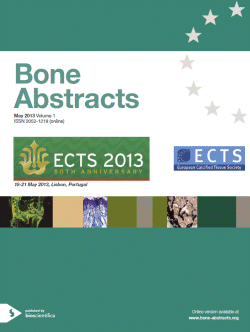
European Calcified Tissue Society Congress 2013
Lisbon,
Portugal
18 May 2013 - 22 May 2013

Poster Presentations
Clinical case posters
ba0001pp1 | Clinical case posters | ECTS2013
Ten years follow up after prenatal transplantation of fetal mesenchymal stem cell in a patient with severe osteogenesis imperfecta
Gotherstrom Cecilia , Blanc Katarina Le , Astrom Eva , Taslimi Jahan , Graham Gail E , Ewald Uwe , Westgren Magnus
ba0001pp2 | Clinical case posters | ECTS2013
Osteonecrosis of the jaw in a patient with rheumatoid artritis treated with an oral aminobisphosphonate: a clinical case report
Longato Lorena , Cavalli Loredana , Marcucci Gemma , Metozzi Alessia , Giusti Francesca , Brandi Maria Luisa , Piscitelli Prisco
ba0001pp3 | Clinical case posters | ECTS2013
The possibility rule of new mutations in juvenile Paget's disease (A rare case of mild JPD)
Donath Judit , Speer Gabor , Kosa Janos , Lakatos Peter , Poor Gyula
ba0001pp4 | Clinical case posters | ECTS2013
The impact of calcimimetic treatment on bone turnover in a renal patient with high turnover hyperparathyroid bone disease
Murray Barbara , Kinsella Sinead , McQuillan Rory , Watson Alan
ba0001pp5 | Clinical case posters | ECTS2013
Late onset autosomal dominant hypophosphatemic rickets; confirmation of the diagnosis with genomic analysis
Tournis Symeon , Stathopoulos Ioannis , Lampropoulou-Adamidou Kalliopi , Koromila Theodora , Chatzistamatas Nikolaos , Droggaris Michail , Zafeiris Christos , Makris Konstantinos , Marketou Helen , Papaioannou Nikolaos , Kollia Panagoula , Gazi Gazi
ba0001pp6 | Clinical case posters | ECTS2013
Diagnosis of fibrous dysplasia with DNA tests
Stathopoulos Ioannis , Balanika Alexia , Baltas Christos , Lampropoulou-Adamidou Kalliopi , Koromila Theodora , Kollia Panagoula , Tournis Symeon , Papaioannou Nikolaos , Katsalira Aikaterini
ba0001pp7 | Clinical case posters | ECTS2013
Severe pregnancy- and lactation-associated osteoporosis: teriparatide treatment
Lampropoulou-Adamidou Kalliopi , Kosmidis Christos , Stathopoulos Ioannis P , Papaioannou Nikolaos A , Trovas George
ba0001pp8 | Clinical case posters | ECTS2013
Phenotypic change in a patient with hypophosphatasia with the onset of renal failure
Cundy Tim , Michigami Toshimi , Tachikawa Kanako , Dray Michael , Collins John
ba0001pp9 | Clinical case posters | ECTS2013
Fibrodysplasia ossificans progressiva
Altin Firuzan , Burnaz Ozer , Ozgonenel Levent , Caglar Nil
ba0001pp10 | Clinical case posters | ECTS2013
Hadju–Cheney syndrome: report of two cases in a family
Terroso Georgina , Bernardes Miguel , Aleixo Abelha , Madureira Pedro , Vieira Romana , Fonseca Rita , Goncalves Diana , Costa Lucia
ba0001pp11 | Clinical case posters | ECTS2013
Gorham disease: a case with severe cervical spine involvement
Terroso Georgina , Pinho Andre Rodrigues , Carvalho Manuel Santos , Freitas Joana , Serdoura Francisco , Veludo Vitorino
ba0001pp12 | Clinical case posters | ECTS2013
Severe osteoporosis associated with Hajdu–Cheney syndrome: follow-up after 2 years of teriparatide therapy
Terroso Georgina , Bernardes Miguel , Aleixo Abelha , Vieira Romana , Madureira Pedro , Fonseca Rita , Goncalves Diana , Costa Lucia



